Carnwath and Liu in Amazing Stories: Recent Acquisitions at the Palmer Museum
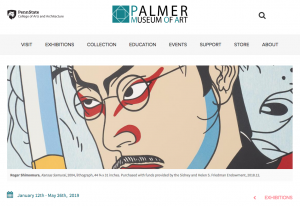
Palmer Museum of Art – Amazing Stories: Recent Acquisitions
“Amazing Stories: Recent Acquisitions” at the Palmer Museum of Art at Penn State highlights a large selection of prints by artists whose work relies heavily on representation and storytelling to explore ethnic identity and stereotypes, multicultural histories, and personal narratives. Artists featured include Turner Carroll artists Squeak Carnwath and Hung Liu, as well as Turner Favorites Claudia Bernardi, Sue Coe, Claudio Dicochea, Leonor Fini, Mimmo Paladino, Roger Shimomura, and Vincent Valdez. Organized by the Palmer Museum of Art. This exhibition runs from January 12 through May 26, 2019. The exhibition may be seen here.
15 January 2019
March 8 – 31, 2017 | Matri-ART-y: Women’s’ March on Art!
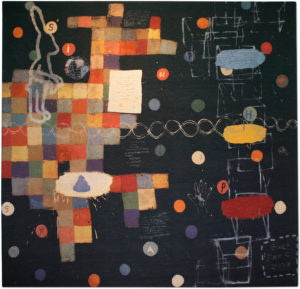
Squeak Carnwath
In a civilization where more than 51% of the population is female, yet 96% of exhibition space is given to men, it’s time for a change. In honor of National Women’s History Month and in celebration of uniquely brilliant female perspective, Turner Carroll features important women artists all month. Artists include an international roster including Nina Tichava, Raphaelle Goethals, Hung Liu, Squeak Carnwath, Karen Yank, Jamie Brunson, Mavis McClure, Jenny Abell, Suzanne Sbarge, Holly Roberts, and Brenda Zappitell.
Opening Reception Friday, March 10, 2017 from 5 to 7pm
[n.b. that this event takes place in Santa Fe]
Symbol Pleasures in Visual Art Source
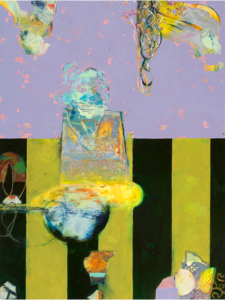
Symbol Pleasures in Visual Art Source
Orlando Leyba, Walter Robinson and Squeak Carnwath: Symbol Pleasures was written up as a recommendation by the most excellent Jon Carver as a recommendation in the 15 October 2016 edition of Visual Art Source. “Make my funk the P-Funk…”
A link to the feature in VAS is here.
April 14 – 17, 2016 | Turner Carroll at the Dallas Art Fair
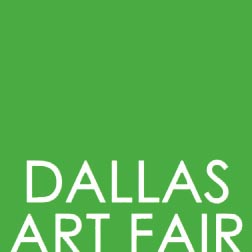
Dallas Art Fair
Located at the Fashion Industry Gallery, adjacent to the Dallas Museum of Art in the revitalized downtown arts district. Featuring new works by gallery artists Fausto Fernandez, Hung Liu, Squeak Carnwath, Drew Tal, Jamie Brunson, Rusty Scruby, Edward Lentsch, Wanxin Zhang, Suzanne Sbarge, Karen Yank, Scott Greene, Holly Roberts, and more! Fair hours are Friday and Saturday, April 15 and 16 respectively, from 11am to 7pm, and Sunday, April 17 from 12pm to 6pm, with an opening preview gala Thursday, April 14.
A link to the Dallas Art Fair is here.
Art in America
Squeak Carnwath’s first New York exhibition in over a decade was tightly packed with paintings, sculptures and works on paper from the 1990s to the present. The earliest piece on view was the painting Things Green (1995). Designed as a giant chart, it presents a list of nouns floating in a field of bright green above a 12-by-21-unit grid, each cell containing a number and a dab of paint. The color swatches represent a wide range of tints, from lemon yellow and sky blue to gray and olive brown, all of which may conceivably contain green pigment. Similarly, every written word has a connection to green, through custom or association. The list includes “snake,” “stone” and “grass” as well as “house,” “peace” and “beret.”
The list of nouns is far from exhaustive, the enumeration inaccurate and some of the cells empty, yet the flaws of the Things Green chart become assets of the painting, which combines poetic sensibility with irresistible physical presence. Carnwath’s principal talent is her ability to transform inert materials into something akin to living matter. In her work, every wobbly line has a character, each handwritten word has its own quirky temperament, and dabs of color have different shapes and moods, like specimens in a collection of bugs.
Carnwath’s most recent paintings were installed in the second gallery. Dense with titles of popular songs handwritten in block letters on narrow bands of contrasting colors, they were each accompanied by a small iPod shuffle playing the referenced songs—a pleasant but redundant gesture. In some paintings, the found poetry of individual song titles accumulates to powerful effect. In Girls (2015), for example, the titles painted in various shades of pink, red and purple reflect many different aspects of gender, from innate character to performative identity to social function: “I Was Born This Way,” “Bang Bang,”“Piece of My Heart,”“I Am Woman.”
Text and color swatches comprise only part of a large vocabulary of shapes, symbols and gestures that have recurred throughout Carnwath’s paintings over the years, traveling from one piece to another and generating a visual conversation among the works. One of the frequent motifs is a trompe l’oeil sheet of lined notebook paper. In the 2002 diptych Everything 2, three such sheets, covered with various marks and pencil scribbles, are depicted on the right-hand panel, painted with easy and casual confidence on top of dozens of vertical stripes of color. The diptych’s left panel features marks and vignettes scattered on a pale background: a handful of colored circles; schematic images such as a rabbit and a palm-reading chart; laconic statements painted in large block letters (“THIS IS A BRILLIANT PAINTING” and “PLEASE HELP”); another trompe l’oeil notebook page; several bits of text floating in different parts of the canvas; and dozens of painterly trifles and accidents, from doodles scraped into wet ground to droplets and streaks of multicolored paint enhancing the canvas’s already richly nuanced surface.
Like most of Carnwath’s pieces, Everything 2 demands sustained viewing. The abundance of visual and textual information seems to imply that some kind of message is there waiting to be deciphered. The clues, however, do not point in a single direction. None of Carnwath’s works in fact offer a comprehensible statement, consistent argument or specific emotion. Instead, they mesmerize the viewer with their tremendous arsenal of painterly gestures, symbols and contradictory statements, transporting one into a state of sensory overload, intellectual excitement and puzzlement.
Article
Turner Carroll Artists in the News
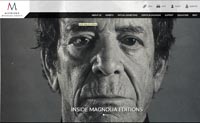
Willy Bo Richardson
Willy Bo Richardson was recently featured in the Latin American edition of Dental Tribune. In addition to having the cover, Willy was interviewed for the magazine by photographer Eric Kroll, A link to the article is here. Inside Magnolia Editions: Collaboration and Innovation opens at the Art Museum of Sonoma County on 12 December 2015. Under the direction of Don and Era Farnsworth since 1981, Magnolia Editions has been on the front lines of innovation, collaboration, and advocacy for timely and pressing social and political issues. The exhibition runs through 7 February 2016. A link to the museum is here.
Turner Carroll artists Rupert Garcia, Squeak Carnwath, Deborah Oropallo, Chuck Close, Enrique Chagoya and Hung Liu all have works represented in the show. Also showing this month is Wanxin Zhang at the San Jose Museum of Art. The show Character Studies: Clay from the Collection runs through 7 February 2016. Wanxin’s work was pointed out “one of a new generation who are continuing this region’s legacy of prominence and innovation in the medium.” The exhibition page of the museum’s web site is here.
Squeak Carnwath at the Lux Art Institute and Upcoming at the di Rosa
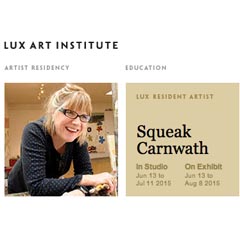
Squeak Carnwath at the Lux Art Institute
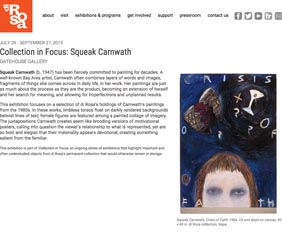
Collection in Focus: Squeak Carnwath
Squeak wraps up her residency at the Lux Art Institute in Encinitas this month with an exhibition running from 13 June to 8 August 2015. To quote from their website, “At Lux, you don’t just see finished works of art; you see the artistic process firsthand, engaging with internationally recognized artists in a working studio environment.” A link to the exhibition is here.
A bit later, from 29 July to 27 September 2015, Squeak will have a solo exhibition at the diRosa. The show, Collection in Focus: Squeak Carnwath, features a group of important and understudied works from the 1980s that are Carnwath pieces held in the di Rosa’s extensive collection. The di Rosa wensite goes on to say about Squeak that she “has been fiercely committed to painting for decades…Carnwath often combines layers of words and images, fragments of things she comes across in daily life…Her paintings are just as much about the process as they are the product, becoming an extension of herself and her search for meaning, and allowing for imperfections and unplanned results.
Great Interview with Squeak Carnwath in Professional Artist Magazine
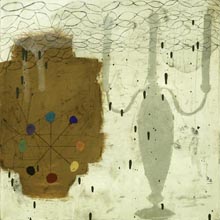
Squeak Carnwath – Catch Light 2
Professional Artist Magazine just published a great interview with our own Squeak Carnwath. Artist Brenda Hope Zapitell asked great questions, and, in turn, received great and elucidating answers. You can find out why Squeak is a “painting chauvinist” and see a hand-printed list by Squeak asking “What artists do you like? A very partial list.” Good stuff.
A link to the article is here.
Hung Liu and Squeak Carnwath Update

Hung Liu – Luzao (Stove)
Hung Liu’s etching “Luzao (Stove)” featured in the SF Chronicle review of West Coast Ink at the Sonoma Museum. Link to the article is here. In addition, Hung is in conversation with Peter Selz at University Press Books in Berkeley, California on 16 April 2014. Selz is one of this country’s most prominent art critics and writers, having published 17 books, and held posts at the University of California at Berkeley, and at MoMA in New York.
Also in the news in Squeak Carnwath, who spoke at Mills College. in Oakland, California recently.
The New York Time – Where ‘Art’ Has Met ‘Craft’ for 100 Years
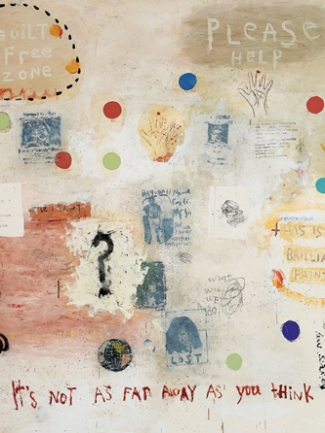
Squeak Carnwath
Oakland, Calif.
WHEN the 1906 San Francisco earthquake destroyed his shop, Frederick Meyer, a German-born cabinetmaker with links to the Arts and Crafts movement, turned disaster into opportunity. The next year he and his wife, Laetitia, opened the School of the California Guild of Arts and Crafts with 3 teachers and 43 students. They had $45 in the bank and a vision of providing rigorous training to fine artists and craftsmen alike.
That school is now the California College of the Arts, a remarkable Bay Area institution that while perhaps unfamiliar outside the region has played an important role in shaping the past 100 years of California art.
“From the beginning the unity of arts and crafts was the most important principle at C.C.A., just like it would be at the Bauhaus, which was established 12 years later,” said Peter Selz, professor emeritus of art history at the University of California, Berkeley. In 1959, while a curator at the Museum of Modern Art in New York, he exhibited two little-known painters with connections to the college, Richard Diebenkorn and Nathan Oliveira.
Both those successful artists are now among the 100 alumni and faculty members whose work is in “Artists of Invention: A Century of C.C.A.,” on view until March 16 at the Oakland Museum of California. It is a wide-ranging exhibition of diverse work: Not far from Mr. Diebenkorn’s elegant canvas is a funky ceramic woman by Viola Frey, one of Robert Bechtle’s photorealist street scenes and a video of compressed television images by Anthony Discenza. In an adjoining space a colorful 1995 Squeak Carnwath painting hangs within sight of a muscular abstract sculpture in blue-gray stoneware by Peter Voulkos and Garry Knox Bennett’s pivotal 1979 work, “Nail Cabinet,” an exquisite wood cabinet he deliberately vandalized by driving a nail into its front.
Elsewhere in the galleries a 1965 Kay Sekimachi woven piece floats like a phantasmagoric undersea creature, while John McCracken’s solitary green plank leans against a wall close to a spectral female plaster figure by Manuel Neri, a dirt-on-paper work by David Ireland and a bronze self-portrait, with tongue sticking out, by Robert Arneson.
“The fact that fine arts people and crafts people were all thrown together made a difference,” said Philip Linhares, the museum’s chief curator of art, who helped organize the exhibition and attended the college in the late 1950s.
When its founder, Mr. Meyer, began in 1907 he rented three rooms in Berkeley because, he later wrote, his “experience with students in San Francisco made me think it was better to hold the school in Berkeley where alcoholic beverages were not on sale.”
In 1936, after the growing institution had moved to a four-acre Victorian estate in Oakland, it became the California College of Arts and Crafts. In 2003, after a second campus was established in a rehabilitated Greyhound bus maintenance building in San Francisco, it was renamed the California College of the Arts. But the underlying philosophy stayed the same.
“There has always been an emphasis on technical proficiency, on craftsmanship and discipline, as much as on inspiration and intuition,” Mr. Selz said of the college.
Squeak Carnwath Updates

Squeak Carnwath
This spring is a busy one for Squeak Carnwath. She just gave a talk at the wonderful Oakland Museum of California, the site of the monumental 2009 Squeak Carnwath 30-year survey exhibition. From February through April 2011 Squeak’s prints from Island Press in St. Louis are in an exhibition at the Mildred Lane Kemper Museum in St. Louis. And from March through May 2011 Squeak has a solo exhibition at the Triton Museum of Art in Santa Clara, California, and is in a show at the Kala Institute in Berkeley, California. Also in March this year is an exhibition of American printmaking at the Shanghai Art Museum in China that includes Squeak’s work. Finally, from March through July 2011 The Missing Peace: Artists Consider the Dalai Lama exhibition travels to the San Antonio Museum of Art for the last show in a five year tour.
The New York Times – Art in Review

Squeak Carnwath
Squeak Carnwath Ledisflam Gallery 130 Prince Street SoHo Through Oct. 2
Art that looks as if it was produced by an angry, precocious child is one of the hallmarks of the last few years, although the work of the California painter Squeak Carnwath has been assuming this posture since the 1970’s.
The five paintings in this show find Ms. Carnwath in good and characteristic form. She builds up layers of pigment so that her colors bleed up from beneath, and her wide surfaces have the rich patina of often-painted walls. Small, crudely rendered body parts — feet, ears, genitals — float like bits of graffiti, and one painting has at its center the outline of an immense human head filled with imprints of the artist’s hands.
Ms. Carnwath’s early use of words in her paintings also anticipated a current trend among younger artists, although in content and tone her texts are distinctly her own. In “What Is Blue” they are part of an elaborate cataloguing game, which includes lists of nouns with blue associations, such as skies, blood, laws and ribbons. Elsewhere, sentences printed in a sprawling, infantile scrawl have the sound of exhortations. “There are secrets in everyday breath,” reads one painting, while another says: “The phone rings. It is a wakeup call to be the one who is awake.” Ms. Carnwath’s anxious, inspirational messages, like the very beautiful colors in her paintings, seem meant to be taken at face value, and at a time when irony is coin of the realm in art, their adamant guilelessness has a refreshing ring.
Full Article

